
Chapter 7 Section II, Part A1-Interpersonal Writing: E-mail Reply
The first part of Section II is the Interpersonal Writing task.
For this task you are to write a formal response to an email.
You have 15 minutes to read the email and respond. In your response, you have to do the following:
Write a response that clearly maintains the exchange
Use a formal tone throughout
Answer all questions asked in the original email
Ask more information about something mentioned in the original message or is relevant to the topic of the message.
A. Scoring Your Email
What you were able to do.
Did you maintain the exchange?
Did you answer all questions and elaborate on your answers?
Did you ask a question relating to the topic?
Did you use a formal tone throughout?
How you were able to do it.
Is your response fully comprehensible?
Did your use of language show some sophistication?
Is your response well organized?
If you answered yes to all the above questions, your performance on this section likely will score in the high range.
B. Strategies For Task 1: Email Reply
Read the introduction and the mail (2 to 3 minutes).
Identify who sent this email and why.
Identify the questions you need to answer.
Underline them so that you can refer back to them quickly.
Make note of any information that is mentioned that you could ask for more details about.
Make note of any cultural references in the original message (origin of the author, and so on).
Writing your reply (8 to 10 minutes).
Use the formal register throughout your response.
Structure your response correctly (greeting, opening, body, closing, goodbye).
Respond to all the questions being asked and elaborate briefly on your responses.
Request more information about something that was mentioned or about something related to the theme.
Vary your vocabulary.
Keep your ideas simple and clear.
Include a variety of tenses and/or moods, if appropriate. Do not try to force the use of different tenses or moods, as this will count against you if it makes your response confusing.
If you make a mistake, draw a line through it and keep writing.
After you finish writing (2 to 5 minutes)
Proofread your reply to make sure that . . .
. . . you have addressed all the elements in the email, including asking for more details;
. . . you have used a variety of vocabulary;
. . . your ideas are clear and concise; and
. . . you used correct orthography, punctuation, and paragraphing.
C. Writing your Email
A good email should be divided into the following 5 sections:
GREETING. Should be appropriate for a formal correspondence.
Estimado(a)
Señor(a)
Buenos días,
Señor(a)
OPENING. These are one or two sentences in which you acknowledge receipt of the message and convey any feelings and emotions from having read this message and/or in which you make a general comment related to the topic.
Le agradezco mucho por su mensaje.
Espero que todo esté bien con usted.
BODY. This is the bulk of your response. Answer the questions asked in the original email and elaborate briefly on each answer. Be creative with your elaboration but make sure that the ideas you write are appropriate for a formal situation. Include a question that is relevant and appropriate within the context.
CLOSING. This is one or two sentences in which you again express your gratitude to the recipient of the email, reiterate some of the information mentioned in the body, and/or express that you look forward to hearing back from this person soon.
Muchas gracias por su amable atención.
Quedo a la espera de su respuesta.
Quedo a su disposición para facilitarle cualquier otra información.
GOODBYE. Should be appropriate for a formal correspondence.
Le saluda cordialmente
Atentamente
Respetuosament
Here are some useful transitions that you can use often in your email replies:
To introduce an idea
Para empezar. . .
En primer lugar. . .
To add to ideas
Además. . .
También. . .
To contrast ideas
En cambio. . .
No obstante. . .
Por otro lado. . .
Sin embargo. . .
To change topic
Con respecto a. . .
En cuanto a. . .
To show effect
Como resultado. . .
Debido a lo anterior. . .
Entonces. . .
Por consiguiente. . .
Por eso. . .
Por esa razón. . .
To give examples
Por ejemplo. . .
En particular. . .
To finalize
Finalmente
Para concluir
D. Sample Email Reply
DIRECTIONS: You will write a reply to an email that you received. You have 15 minutes to read the message and write your reply. Your reply should include an appropriate greeting and closing and should answer all the questions and requests in the original message. In addition, your reply should ask for more details about something that was mentioned in the message. You should use a formal tone in your response. Vas a escribir una respuesta a un mensaje de correo electrónico. Tienes 15 minutos para leer el mensaje y escribir tu respuesta. Tu respuesta debe incluir un saludo y despedida apropiada y contestar a todas las preguntas y peticiones del mensaje original. También tu respuesta debe pedir más información de algo mencionado en el mensaje original. Debes usar el tono formal en tu respuesta. |
|---|
Tema curricular: Las identidades personales y públicas
Este mensaje electrónico es de María José Martínez Vargas, directora de un programa a que has solicitado. Te escribe para informarte que has sido seleccionado finalista.
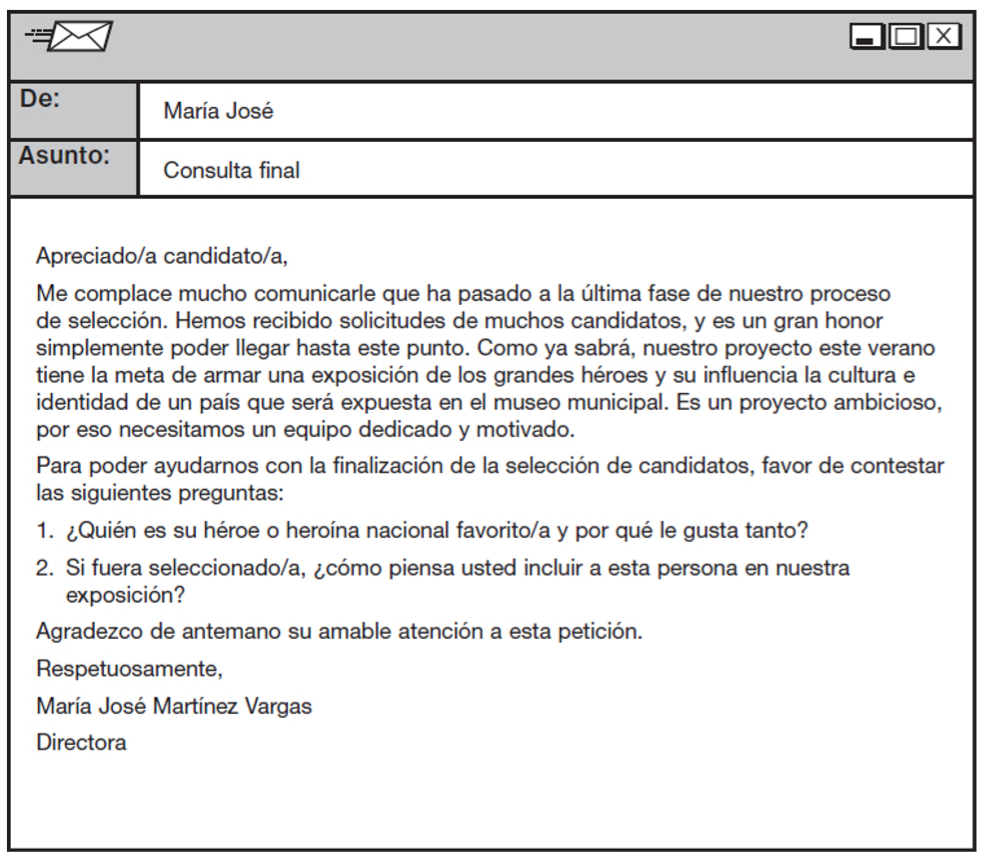
Response
Reply to the email
Answer all questions asked
Ask an appropriate question related to the topic
Use a formal tone
Take notes this following important information:
You have applied for this position (so it is something of obvious interest to you).
You have not received the position but are a finalist for it.
The person who is writing to you is the director of the program, and she is female.
As you begin to put pen to paper, you need to think quickly about how you will answer the questions she has asked. In her email, María José wants to know the following:
(1) Who is your favorite national hero and why?
(2) How do you plan on showcasing this person at the exposition?
The next part is to figure out how you would include this figure in the exposition. You will have to be creative here, but anything that would be appropriate in a museum setting could work.
The last part is to identify something that you may need to know more about. In this email, there are several questions that you could ask. Here are a few:
◇ How many candidates are finalists
◇ How many candidates are finalists? ?
◇When will the exposition take place?
◇How long will the exposition last?
◇How many people will form the team?
◇What types of resources will be available to assemble the exposition?
◇Is this a paid position?
◇When will the selected candidates be announced?
◇When in the summer is the exposition?
Sample Response
Estimada Directora, En primer lugar quisiera agradecerle por haberme seleccionado como finalista. Estoy muy emocionado saber que tengo la oportunidad de participar en esta fantástica exposición. Para contestar a sus preguntas, de niño, siempre me han fascinado los grandes héroes nacionales, pero si fuera de solamente escoger uno, sería José Martí. Me fascina tanto porque a través de su literatura ayudó a crear una identidad cubana, que sirvió de fuerza unificadora para la gente de la isla. También, murió en batalla tratando de liberar su país de los españoles. En la exposición, me gustaría incorporar ejemplos de su literatura para mostrar cómo sirvió para crear esta identidad nacional. Sería interesante incorporar partes de sus Versos Sencillos, y crear talleres donde los visitantes pueden mejor comprender su obra y formar versos originales que definan su propia identidad cultural. Me emociona muchísimo saber que soy finalista. ¿Sabe usted cuándo van a seleccionar al solicitante ganador? Muchísimas gracias otra vez por correspondencia, y quedo a su disposición para facilitarle cualquier otra información. Atentamente, Javier Benavidez |
|---|
As you look over this response, make note of the following:
The organization of the response into the five distinct portions (greeting, opening, body, closing, goodbye)
Use of transitions (En primer lugar . . . , Para contestar a sus preguntas . . . , También . . .)
Elaboration following the answer of each question
Use of formal tone throughout
Use of a variety of verb moods and tenses (present, preterit, conditional, imperfect subjunctive)
Also note what is not in the response, such as your email address or the date. These elements are not required for this task and are simply a waste of time.
E. Email Reply Practice Exercises
EMAIL REPLY #1
Tema curricular: Los desafíos mundiales
Este mensaje electrónico es del señor Javier Gaitán, el presidente del Club Planeta Verde. Él está planeando publicar un informe sobre la situación del medio ambiente. Has recibido este mensaje porque vives en la comunidad en que se ubica este club.

EMAIL REPLY #2
Tema curricular: La belleza y la estética
Este mensaje te lo envió el Profesor Gutiérrez, profesor de teatro de tu escuela. Te escribe porque quiere hacerte encargo del decorado para la obra de teatro Sueño, que va a estrenar el próximo mes.
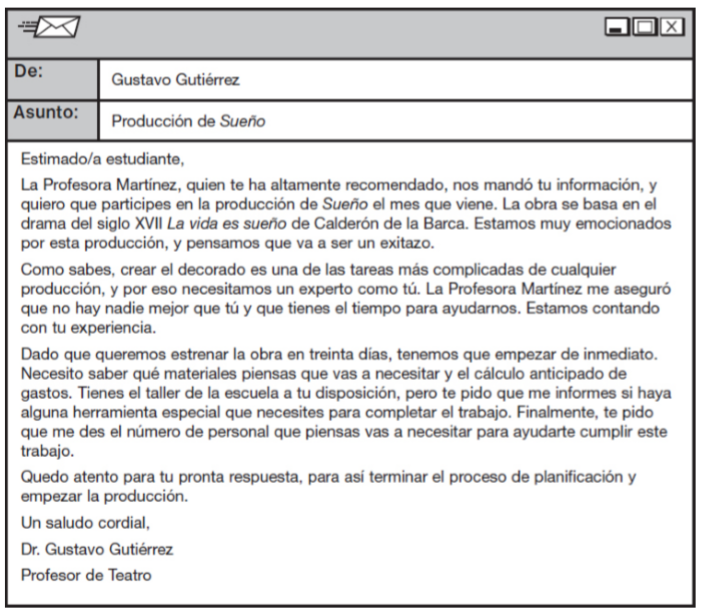
EMAIL REPLY #3
Tema curricular: La vida contemporánea
Este mensaje electrónico es de la señora Carmen Cienfuegos, la directora de Voluntariado Universal. Has recibido este mensaje porque has aceptado participar en uno de sus programas en Argentina.
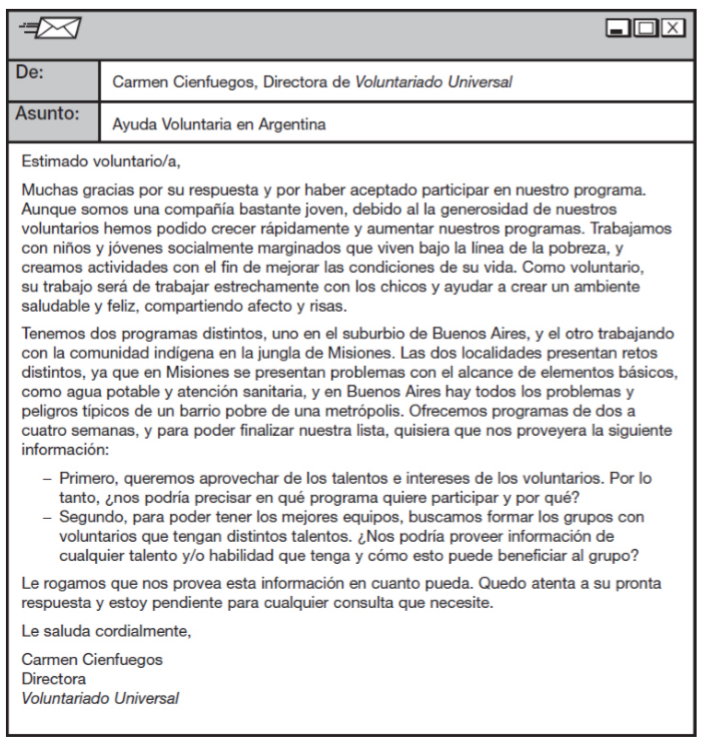
EMAIL REPLY #4
Tema curricular: Las identidades personales y públicas
Eres estudiante en el colegio y tu escuela va a patrocinar una mesa redonda sobre la religión. Una profesora tuya, quien va a ser uno de los panelistas, quiere incorporar las ideas de varios estudiantes. Te manda un mensaje electrónico pidiendo que la ayudes en prepararse para la discusión.

EMAIL REPLY #5
Tema curricular: Las familias y las comunidades
Un periodista de una revista popular está preparando un artículo sobre las diferentes tradiciones que se celebran en distintas comunidades. Te manda un mensaje electrónico pidiendo que respondas a unas preguntas para ayudarlo en terminar su trabajo.

EMAIL REPLY #6
Tema curricular: La ciencia y la tecnología
Eres estudiante a punto de empezar tu primer semestre en la universidad y un decano te escribe un mensaje electrónico. Quiere saber tus opiniones sobre si se debería permitir el uso de teléfonos celulares en las aulas.
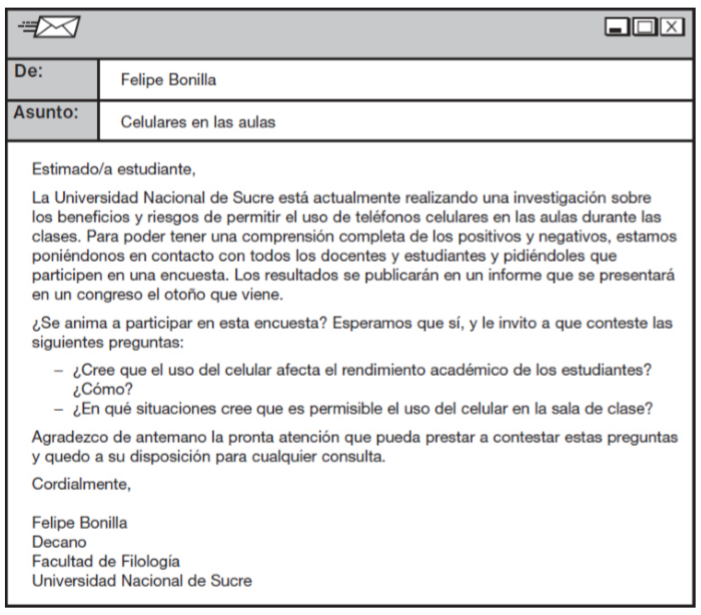
EMAIL REPLY #7
Tema curricular: Los desafíos mundiales
Recibes un mensaje electrónico de Annet Romero, asistente ejecutiva del alcalde en tu ciudad. Están pensando en implementar unas reformas a unos programas sociales y quiere saber tu opinión sobre el asunto.

EMAIL REPLY #8
Tema curricular: La vida contemporánea
Acabas de recibir un mensaje electrónico del gerente de tu restaurante favorito. Te escribe porque quiere que participes en un evento para recaudar fondos para un nuevo parque infantil.
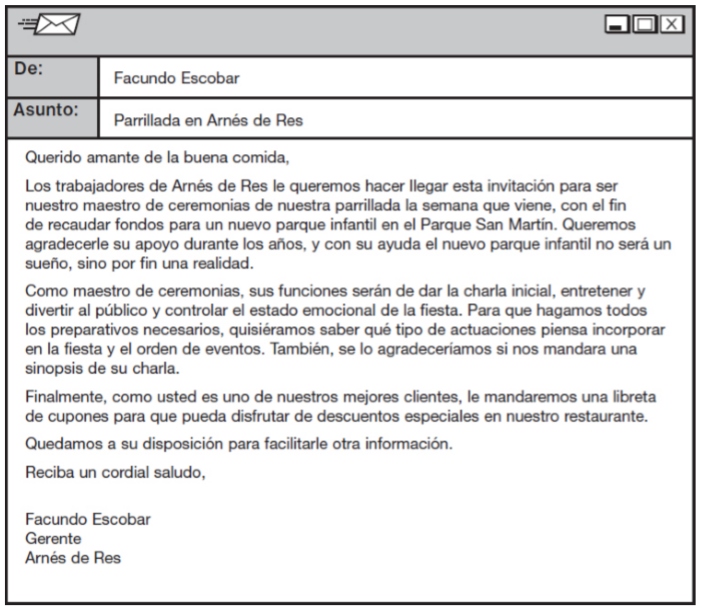
EMAIL REPLY #9
Tema curricular: Las familias y las comunidades
Eres estudiante y recibes un mensaje electrónico de tu profesor pidiendo información de tu proyecto final del curso.

EMAIL REPLY #10
Tema curricular: La belleza y la estética
Eres un estudiante de diseño que acaba de calificarse a la siguiente ronda de un concurso de productos innovadores. Recibes un mensaje electrónico de la directora del concurso en que te felicita y te informa del próximo paso.
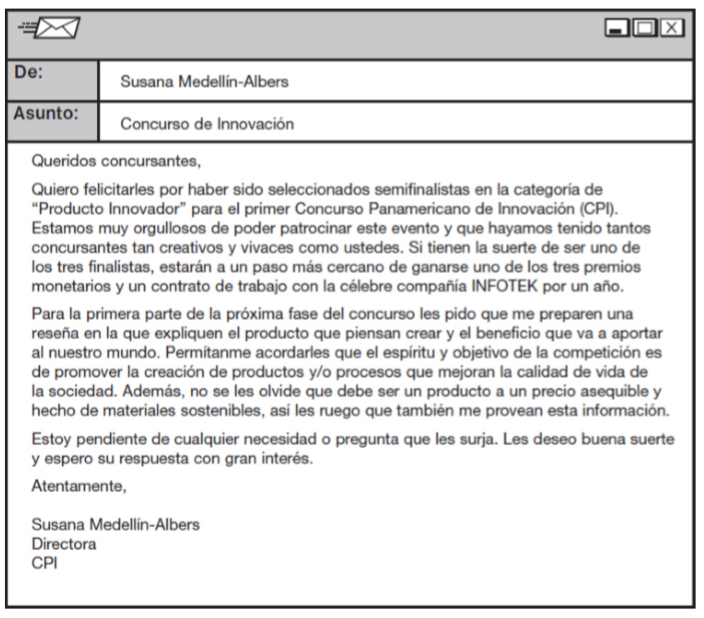
Chapter 7 Section II, Part A1-Interpersonal Writing: E-mail Reply
The first part of Section II is the Interpersonal Writing task.
For this task you are to write a formal response to an email.
You have 15 minutes to read the email and respond. In your response, you have to do the following:
Write a response that clearly maintains the exchange
Use a formal tone throughout
Answer all questions asked in the original email
Ask more information about something mentioned in the original message or is relevant to the topic of the message.
A. Scoring Your Email
What you were able to do.
Did you maintain the exchange?
Did you answer all questions and elaborate on your answers?
Did you ask a question relating to the topic?
Did you use a formal tone throughout?
How you were able to do it.
Is your response fully comprehensible?
Did your use of language show some sophistication?
Is your response well organized?
If you answered yes to all the above questions, your performance on this section likely will score in the high range.
B. Strategies For Task 1: Email Reply
Read the introduction and the mail (2 to 3 minutes).
Identify who sent this email and why.
Identify the questions you need to answer.
Underline them so that you can refer back to them quickly.
Make note of any information that is mentioned that you could ask for more details about.
Make note of any cultural references in the original message (origin of the author, and so on).
Writing your reply (8 to 10 minutes).
Use the formal register throughout your response.
Structure your response correctly (greeting, opening, body, closing, goodbye).
Respond to all the questions being asked and elaborate briefly on your responses.
Request more information about something that was mentioned or about something related to the theme.
Vary your vocabulary.
Keep your ideas simple and clear.
Include a variety of tenses and/or moods, if appropriate. Do not try to force the use of different tenses or moods, as this will count against you if it makes your response confusing.
If you make a mistake, draw a line through it and keep writing.
After you finish writing (2 to 5 minutes)
Proofread your reply to make sure that . . .
. . . you have addressed all the elements in the email, including asking for more details;
. . . you have used a variety of vocabulary;
. . . your ideas are clear and concise; and
. . . you used correct orthography, punctuation, and paragraphing.
C. Writing your Email
A good email should be divided into the following 5 sections:
GREETING. Should be appropriate for a formal correspondence.
Estimado(a)
Señor(a)
Buenos días,
Señor(a)
OPENING. These are one or two sentences in which you acknowledge receipt of the message and convey any feelings and emotions from having read this message and/or in which you make a general comment related to the topic.
Le agradezco mucho por su mensaje.
Espero que todo esté bien con usted.
BODY. This is the bulk of your response. Answer the questions asked in the original email and elaborate briefly on each answer. Be creative with your elaboration but make sure that the ideas you write are appropriate for a formal situation. Include a question that is relevant and appropriate within the context.
CLOSING. This is one or two sentences in which you again express your gratitude to the recipient of the email, reiterate some of the information mentioned in the body, and/or express that you look forward to hearing back from this person soon.
Muchas gracias por su amable atención.
Quedo a la espera de su respuesta.
Quedo a su disposición para facilitarle cualquier otra información.
GOODBYE. Should be appropriate for a formal correspondence.
Le saluda cordialmente
Atentamente
Respetuosament
Here are some useful transitions that you can use often in your email replies:
To introduce an idea
Para empezar. . .
En primer lugar. . .
To add to ideas
Además. . .
También. . .
To contrast ideas
En cambio. . .
No obstante. . .
Por otro lado. . .
Sin embargo. . .
To change topic
Con respecto a. . .
En cuanto a. . .
To show effect
Como resultado. . .
Debido a lo anterior. . .
Entonces. . .
Por consiguiente. . .
Por eso. . .
Por esa razón. . .
To give examples
Por ejemplo. . .
En particular. . .
To finalize
Finalmente
Para concluir
D. Sample Email Reply
DIRECTIONS: You will write a reply to an email that you received. You have 15 minutes to read the message and write your reply. Your reply should include an appropriate greeting and closing and should answer all the questions and requests in the original message. In addition, your reply should ask for more details about something that was mentioned in the message. You should use a formal tone in your response. Vas a escribir una respuesta a un mensaje de correo electrónico. Tienes 15 minutos para leer el mensaje y escribir tu respuesta. Tu respuesta debe incluir un saludo y despedida apropiada y contestar a todas las preguntas y peticiones del mensaje original. También tu respuesta debe pedir más información de algo mencionado en el mensaje original. Debes usar el tono formal en tu respuesta. |
|---|
Tema curricular: Las identidades personales y públicas
Este mensaje electrónico es de María José Martínez Vargas, directora de un programa a que has solicitado. Te escribe para informarte que has sido seleccionado finalista.

Response
Reply to the email
Answer all questions asked
Ask an appropriate question related to the topic
Use a formal tone
Take notes this following important information:
You have applied for this position (so it is something of obvious interest to you).
You have not received the position but are a finalist for it.
The person who is writing to you is the director of the program, and she is female.
As you begin to put pen to paper, you need to think quickly about how you will answer the questions she has asked. In her email, María José wants to know the following:
(1) Who is your favorite national hero and why?
(2) How do you plan on showcasing this person at the exposition?
The next part is to figure out how you would include this figure in the exposition. You will have to be creative here, but anything that would be appropriate in a museum setting could work.
The last part is to identify something that you may need to know more about. In this email, there are several questions that you could ask. Here are a few:
◇ How many candidates are finalists
◇ How many candidates are finalists? ?
◇When will the exposition take place?
◇How long will the exposition last?
◇How many people will form the team?
◇What types of resources will be available to assemble the exposition?
◇Is this a paid position?
◇When will the selected candidates be announced?
◇When in the summer is the exposition?
Sample Response
Estimada Directora, En primer lugar quisiera agradecerle por haberme seleccionado como finalista. Estoy muy emocionado saber que tengo la oportunidad de participar en esta fantástica exposición. Para contestar a sus preguntas, de niño, siempre me han fascinado los grandes héroes nacionales, pero si fuera de solamente escoger uno, sería José Martí. Me fascina tanto porque a través de su literatura ayudó a crear una identidad cubana, que sirvió de fuerza unificadora para la gente de la isla. También, murió en batalla tratando de liberar su país de los españoles. En la exposición, me gustaría incorporar ejemplos de su literatura para mostrar cómo sirvió para crear esta identidad nacional. Sería interesante incorporar partes de sus Versos Sencillos, y crear talleres donde los visitantes pueden mejor comprender su obra y formar versos originales que definan su propia identidad cultural. Me emociona muchísimo saber que soy finalista. ¿Sabe usted cuándo van a seleccionar al solicitante ganador? Muchísimas gracias otra vez por correspondencia, y quedo a su disposición para facilitarle cualquier otra información. Atentamente, Javier Benavidez |
|---|
As you look over this response, make note of the following:
The organization of the response into the five distinct portions (greeting, opening, body, closing, goodbye)
Use of transitions (En primer lugar . . . , Para contestar a sus preguntas . . . , También . . .)
Elaboration following the answer of each question
Use of formal tone throughout
Use of a variety of verb moods and tenses (present, preterit, conditional, imperfect subjunctive)
Also note what is not in the response, such as your email address or the date. These elements are not required for this task and are simply a waste of time.
E. Email Reply Practice Exercises
EMAIL REPLY #1
Tema curricular: Los desafíos mundiales
Este mensaje electrónico es del señor Javier Gaitán, el presidente del Club Planeta Verde. Él está planeando publicar un informe sobre la situación del medio ambiente. Has recibido este mensaje porque vives en la comunidad en que se ubica este club.

EMAIL REPLY #2
Tema curricular: La belleza y la estética
Este mensaje te lo envió el Profesor Gutiérrez, profesor de teatro de tu escuela. Te escribe porque quiere hacerte encargo del decorado para la obra de teatro Sueño, que va a estrenar el próximo mes.

EMAIL REPLY #3
Tema curricular: La vida contemporánea
Este mensaje electrónico es de la señora Carmen Cienfuegos, la directora de Voluntariado Universal. Has recibido este mensaje porque has aceptado participar en uno de sus programas en Argentina.

EMAIL REPLY #4
Tema curricular: Las identidades personales y públicas
Eres estudiante en el colegio y tu escuela va a patrocinar una mesa redonda sobre la religión. Una profesora tuya, quien va a ser uno de los panelistas, quiere incorporar las ideas de varios estudiantes. Te manda un mensaje electrónico pidiendo que la ayudes en prepararse para la discusión.

EMAIL REPLY #5
Tema curricular: Las familias y las comunidades
Un periodista de una revista popular está preparando un artículo sobre las diferentes tradiciones que se celebran en distintas comunidades. Te manda un mensaje electrónico pidiendo que respondas a unas preguntas para ayudarlo en terminar su trabajo.

EMAIL REPLY #6
Tema curricular: La ciencia y la tecnología
Eres estudiante a punto de empezar tu primer semestre en la universidad y un decano te escribe un mensaje electrónico. Quiere saber tus opiniones sobre si se debería permitir el uso de teléfonos celulares en las aulas.

EMAIL REPLY #7
Tema curricular: Los desafíos mundiales
Recibes un mensaje electrónico de Annet Romero, asistente ejecutiva del alcalde en tu ciudad. Están pensando en implementar unas reformas a unos programas sociales y quiere saber tu opinión sobre el asunto.

EMAIL REPLY #8
Tema curricular: La vida contemporánea
Acabas de recibir un mensaje electrónico del gerente de tu restaurante favorito. Te escribe porque quiere que participes en un evento para recaudar fondos para un nuevo parque infantil.

EMAIL REPLY #9
Tema curricular: Las familias y las comunidades
Eres estudiante y recibes un mensaje electrónico de tu profesor pidiendo información de tu proyecto final del curso.

EMAIL REPLY #10
Tema curricular: La belleza y la estética
Eres un estudiante de diseño que acaba de calificarse a la siguiente ronda de un concurso de productos innovadores. Recibes un mensaje electrónico de la directora del concurso en que te felicita y te informa del próximo paso.

 Knowt
Knowt
